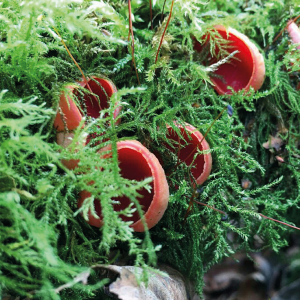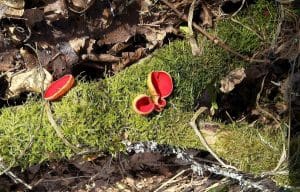Scarlet Elf Cups / Autumn / Winter / Edible
Venture into the captivating realm of Scarlet Elf Cups, a charming and visually striking group of fungi that enchant foragers and nature enthusiasts alike. These enchanting mushrooms, often found nestled in damp, wooded areas, are as delightful to observe as they are to consume.
Common Names
Scarlet Elf cup, scarlet cup fungus, moss cup, fairy bath.
Botanical Name
Sarcoscypha austriaca
Meaning of Botanical Name
Sarcosypha is derived from the two Latin words – Sarco meaning flesh and Skyphos meaning drinking bowl. Austriaca refers to Austria.
Scientific Classification
Kingdom: Fungi, Division: Ascomycota, Subdivision: Pezizomycotina, Class: Pezizomycetes, Order: Pezizales, Family: Sarcoscyphaceae, Genus: Sarcoscypha,
Species: S. austriaca
Known Hazards
Many fungi in the order Pezizales are toxic if consumed raw.
Could be confused with
This fungus is commonly confused with the macroscopically virtually indistinguishable Ruby Elfcup Sarcoscypha coccinea which is similarly edible. Microscopic examination of the latter reveals uncoiled hairs on the outer surface in contrast to coiled ones in the Scarlet Elfcup
Food Plant of
Uncertain, but the fungus is virtually always free of maggots.
Range and Distribution
Common over the northern hemisphere.
Habitat
Commonly found on dead or decaying damp hardwood, specifically around mosses, lichens and leaf litter.
Video of Scarlet Elf Cups Foraging
Physical Characteristics of Scarlet Elf Cups
The fruit body, up to 5cm across is circular or oval, initially, it is cup-shaped, later becoming more disc-shaped, connecting to the substrate with a small stem. The inside of this fungi’s cup is a brilliant red with a smooth and shiny complexion. The outside of the cup and short stem range from a light pink to white and resembled a felted mass of extremely short hairs (under a microscope these are corkscrew shaped).
White spore print (under a microscope these are ellipsoidal with flattened ends containing several oil droplets).



Folklore, tall tales, and not so folklore:
It’s believed that the elves of the wood visit these cups in the morning and drink the dew from them. We like to pretend to be woodland elves, using these magical goblets to drink our sloe gin and birch sap from.
Edible Uses of Scarlet Elf Cups:
Whole fruit body cooked (raw with caution), although be sure to test your sensitivity by only eating a small amount at first – especially if eating raw. Fergus has eaten these raw (with out any problems) for 20 years, but never more than about 10 averaged sized fungi at a time.
The gorgeous colour makes this fungus especially suitable to liven up a salad or as a garnish for consommés.
Herbal
Carotanoids give this fungi is amazing colours, specifically beta-carotene and plectaniaxanthin – which are both noted to slow down the deterioration of eyesight with age.
Miscellaneous
These striking fungi can often be found when collecting the season’s first wild garlic in February.
A rarely recorded white coloured form and a bright yellow variety have also been reported.
Tips and Observations
One of the great things about this fungi is that its amazing colour isn’t lost during cooking and can therefore add a really nice contrast of colour to dishes. They work especially well floated on a consommés, and tossed in green leafy salads, as well as grain salads.
The last word goes to……..
whoever might say or have thought, “these ruby jewels of the elfish realm look so magical amidst the emerald moss that I think I’ll just sit and admire their startling wonderousness, after all, just because they are edible doesn’t mean I have to eat them. What say you elves?”






